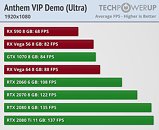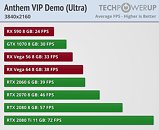Saturday, January 26th 2019

Anthem VIP Demo Benchmarked on all GeForce RTX & Vega Cards
Yesterday, EA launched the VIP demo for their highly anticipated title "Anthem". The VIP demo is only accessible to Origin Access subscribers or people who preordered. For the first hours after the demo launch, many players were plagued by servers crashes or "servers are full" messages. Looks like EA didn't anticipate the server load correctly, or the inrush of login attempts revealed a software bug that wasn't apparent with light load.
Things are running much better now, and we had time to run some Anthem benchmarks on a selection of graphics cards, from AMD and NVIDIA. We realized too late that even the Anthem Demo comes with a five activation limit, which gets triggered on every graphics card change. That's why we could only test eight cards so far.. we'll add more when the activations reset.We benchmarked Anthem at Ultra settings in 1920x1080 (Full HD), 2560x1440 and 3840x2160 (4K). The drivers used were NVIDIA 417.71 WHQL and yesterday's AMD Radeon Adrenalin 19.1.2, which includes performance improvements for Anthem.At 1080p, it looks like the game is running into a CPU bottleneck with our Core i7-8700K (note how the scores for RTX 2080 and RTX 2080 Ti are very close together). It's also interesting how cards from AMD start out slower at lower resolution, but make up the gap to their NVIDIA counterparts as resolution is increased. It's only at 4K that Vega 64 matches RTX 2060 (something that would be expected for 1080p, when looking at results from recent GPU reviews).
We will add test results for more cards, such as the Radeon RX 570 and GeForce GTX 1060, after our activation limit is reset over the weekend.
Things are running much better now, and we had time to run some Anthem benchmarks on a selection of graphics cards, from AMD and NVIDIA. We realized too late that even the Anthem Demo comes with a five activation limit, which gets triggered on every graphics card change. That's why we could only test eight cards so far.. we'll add more when the activations reset.We benchmarked Anthem at Ultra settings in 1920x1080 (Full HD), 2560x1440 and 3840x2160 (4K). The drivers used were NVIDIA 417.71 WHQL and yesterday's AMD Radeon Adrenalin 19.1.2, which includes performance improvements for Anthem.At 1080p, it looks like the game is running into a CPU bottleneck with our Core i7-8700K (note how the scores for RTX 2080 and RTX 2080 Ti are very close together). It's also interesting how cards from AMD start out slower at lower resolution, but make up the gap to their NVIDIA counterparts as resolution is increased. It's only at 4K that Vega 64 matches RTX 2060 (something that would be expected for 1080p, when looking at results from recent GPU reviews).
We will add test results for more cards, such as the Radeon RX 570 and GeForce GTX 1060, after our activation limit is reset over the weekend.






134 Comments on Anthem VIP Demo Benchmarked on all GeForce RTX & Vega Cards
and those who have gtx 1080Ti and RTX 2080 or better should really play games at higher resolutions than 1080p anyway
unless they are making a living off CS
As I keep telling people in Toms forums we still don't need super expensive cpus like i9 9900K or even i7 8700K/9700K to play the latest triple A games
just save your money for a good high res monitor and a good GPU, unless of course you want to play games "professionally"
NVIDIA's higher clock speed leads to lower latency with the workload loop
At higher resolution, there's a higher chance for very wide parallelism workloads which has higher benefits for AMD's lower clock speed GCNs.Raja Koduri joined AMD in 2013 and under Koduri administration, RTG has focused on TFLOPS increase without increasing quad raster engine unit count.
Hawaii doesn't have Polaris delta color compression improvements.
Hawaii doesn't have Polaris 2MB L2 cache improvements. Hawaii has 1MB L2 cache for it's TMUs.
It's most likely VII is stuck in quad raster engine unit count.
www.amd.com/en/support/kb/release-notes/rn-rad-win-19-1-2